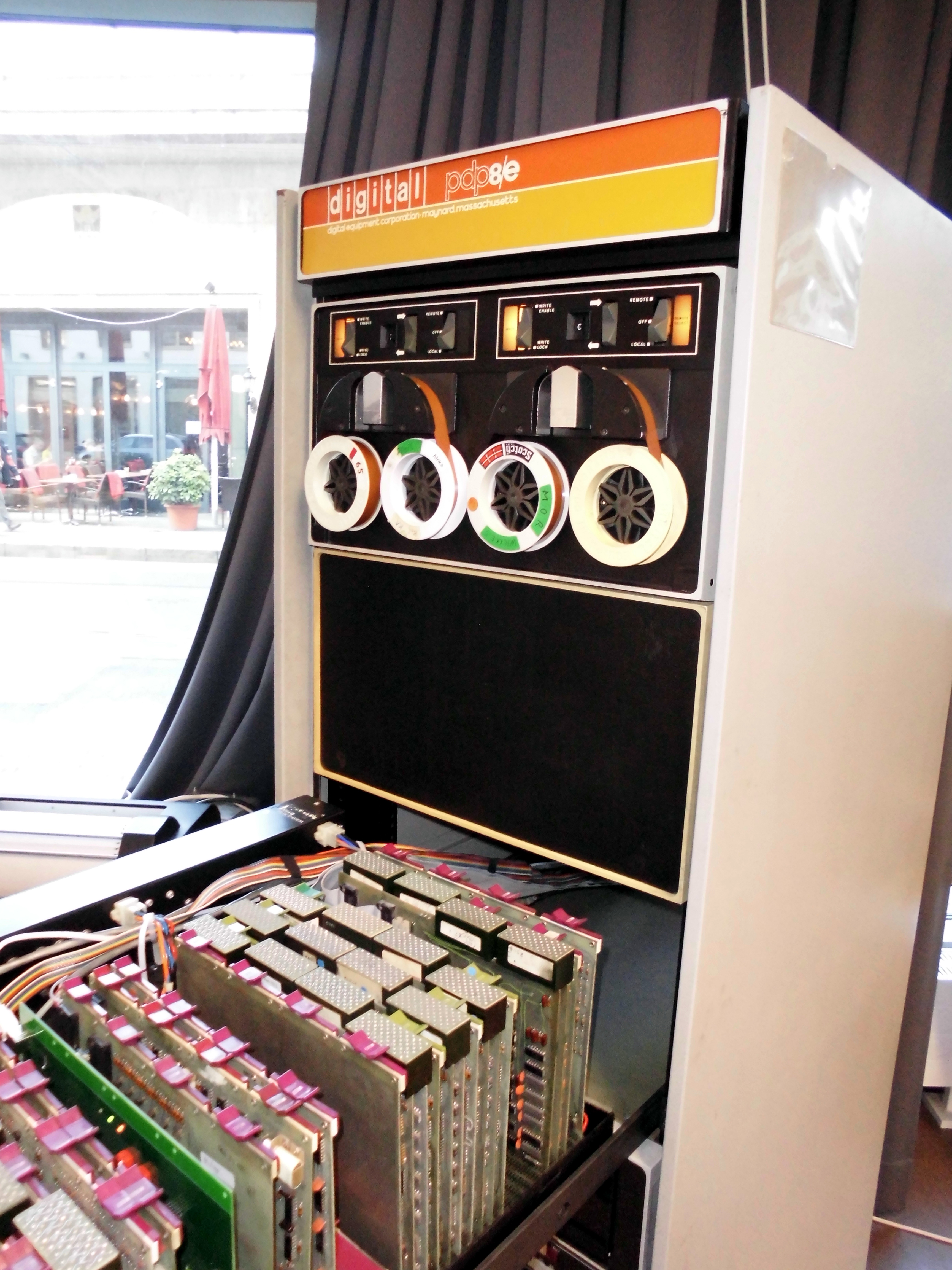|
Serial Computing
A serial computer is a computer typified by bit-serial architecture i.e., internally operating on one bit or digit for each clock cycle. Machines with serial main storage devices such as acoustic or magnetostrictive delay lines and rotating magnetic devices were usually serial computers. Serial computers require much less hardware than their parallel computing counterpart, but are much slower. There are modern variants of the serial computer available as a soft microprocessor which can serve niche purposes where size of the CPU is the main constraint. The first computer that was not serial (the first parallel computer) was the Whirlwind in 1951. A serial computer is not necessarily the same as a computer with a 1-bit architecture, which is a subset of the serial computer class. 1-bit computer instructions operate on data consisting of single bits, whereas a serial computer can operate on ''N''-bit data widths, but does so a single bit at a time. Serial machines * EDVA ... [...More Info...] [...Related Items...] OR: [Wikipedia] [Google] [Baidu] |
Bit-serial Architecture
In digital logic applications, bit-serial architectures send data one bit at a time, along a single wire, in contrast to bit-parallel word architectures, in which data values are sent all bits or a word at once along a group of wires. All digital computers built before 1951, and most of the early massive parallel processing machines used a bit-serial architecture—they were serial computers. Bit-serial architectures were developed for digital signal processing in the 1960s through 1980s, including efficient structures for bit-serial multiplication and accumulation. Often, N serial processors will take less FPGA area and have a higher total performance than a single N-bit parallel processor. See also * 1-bit architecture * Bit banging * Bit slicing * Digit-serial architecture * BKM algorithm * CORDIC algorithm CORDIC (for "coordinate rotation digital computer"), also known as Volder's algorithm, or: Digit-by-digit method Circular CORDIC (Jack E. Volder), Linear CORDI ... [...More Info...] [...Related Items...] OR: [Wikipedia] [Google] [Baidu] |
Bendix G-15
The Bendix G-15 is a computer introduced in 1956 by the Bendix Corporation, Computer Division, Los Angeles, California. It is about and weighs about . The G-15 has a drum memory of 2,160 29-bit words, along with 20 words used for special purposes and rapid-access storage. The base system, without peripherals, cost $49,500. A working model cost around $60,000 (over $500,000 by today's standards). It could also be rented for $1,485 per month. It was meant for scientific and industrial markets. The series was gradually discontinued when Control Data Corporation took over the Bendix computer division in 1963. The chief designer of the G-15 was Harry Huskey, who had worked with Alan Turing on the ACE in the United Kingdom and on the SWAC in the 1950s. He made most of the design while working as a professor at Berkeley, and other universities. David C. Evans was one of the Bendix engineers on the G-15 project. He would later become famous for his work in computer graphics and ... [...More Info...] [...Related Items...] OR: [Wikipedia] [Google] [Baidu] |
ICL Distributed Array Processor
The Distributed Array Processor (DAP) produced by International Computers Limited (ICL) was the world's first commercial massively parallel computer. The original paper study was complete in 1972 and building of the prototype began in 1974. The first machine was delivered to Queen Mary College in 1979. Development The initial 'Pilot DAP' was designed and implemented by Dr Stewart F Reddaway with the aid of David J Hunt and Peter M Flanders at the ICL Stevenage Labs. Their manager and a major contributor was John K Iliffe who had designed the Basic Language Machine—he is well known nowadays for Iliffe vectors. The ICL DAP had 64×64 single bit processing elements (PEs) with 4096 bits of storage per PE. It was attached to an ICL mainframe and its memory was mapped into the mainframe's memory. Programs for the DAP were written in DAP FORTRAN which was FORTRAN extended with 64×64 matrix and 64 element vector primitives. DAP Fortran compiled to an assembly language called APAL (A ... [...More Info...] [...Related Items...] OR: [Wikipedia] [Google] [Baidu] |
Massively Parallel (computing)
Massively parallel is the term for using a large number of computer processors (or separate computers) to simultaneously perform a set of coordinated computations in parallel. GPUs are massively parallel architecture with tens of thousands of threads. One approach is grid computing, where the processing power of many computers in distributed, diverse administrative domains is opportunistically used whenever a computer is available.''Grid computing: experiment management, tool integration, and scientific workflows'' by Radu Prodan, Thomas Fahringer 2007 pages 1–4 An example is BOINC, a volunteer-based, opportunistic grid system, whereby the grid provides power only on a best effort basis.''Parallel and Distributed Computational Intelligence'' by Francisco Fernández de Vega 2010 pages 65–68 Another approach is grouping many processors in close proximity to each other, as in a computer cluster. In such a centralized system the speed and flexibility of the interconnect beco ... [...More Info...] [...Related Items...] OR: [Wikipedia] [Google] [Baidu] |
HP-35
The HP-35 was Hewlett-Packard's first pocket calculator and the world's first ''scientific'' pocket calculator: a calculator with trigonometric and exponential functions. It was introduced in 1972. History In about 1970 HP co-founder Bill Hewlett challenged his co-workers to create a "shirt-pocket sized HP-9100". At the time, slide rules were the only practical portable devices for performing trigonometric and exponential functions, as existing pocket calculators could only perform addition, subtraction, multiplication, and division. Introduced at , like HP's first scientific calculator, the desktop 9100A, it used reverse Polish notation (RPN) rather than what came to be called "algebraic" entry. The "35" in the calculator's name came from the number of keys. The original HP-35 was available from 1972 to 1975. In 2007 HP announced the release of the "retro"-look HP 35s to commemorate the 35th anniversary of the launch of the original HP-35. It was priced at . The HP-35 was na ... [...More Info...] [...Related Items...] OR: [Wikipedia] [Google] [Baidu] |
Datapoint 2200
The Datapoint 2200 was a mass-produced programmable computer terminal usable as a computer, designed by Computer Terminal Corporation (CTC) founders Phil Ray and Gus Roche and announced by CTC in June 1970 (with units shipping in 1971). It was initially presented by CTC as a versatile and cost-efficient terminal for connecting to a wide variety of mainframes by loading various terminal emulations from tape rather than being hardwired as most contemporary terminals, including their earlier Datapoint 3300. However, Dave Gust, a CTC salesman, realized that the 2200 could meet Pillsbury Foods's need for a small computer in the field, after which the 2200 was marketed as a stand-alone computer. Its industrial designer John "Jack" Frassanito has later claimed that Ray and Roche always intended the Datapoint 2200 to be a full-blown personal computer, but that they chose to keep quiet about this so as not to concern investors and others. Also significant is the fact that the terminal's ... [...More Info...] [...Related Items...] OR: [Wikipedia] [Google] [Baidu] |
Kenbak-1
The Kenbak-1 is considered by the Computer History Museum, the Computer Museum of America and the American Computer Museum to be the world's first "personal computer", invented by John Blankenbaker (born 1929) of Kenbak Corporation in 1970, and first sold in early 1971. Less than 50 machines were ever built using Bud Industries enclosures as its housing. The system first sold for US$750. Today, only 14 machines are known to exist worldwide, in the hands of various collectors and museums. Production of the Kenbak-1 stopped in 1973 as Kenbak failed, and was taken over by CTI Education Products, Inc. CTI rebranded the inventory and renamed it the 5050, though sales remained elusive. Since the Kenbak-1 was invented before the first microprocessor, the machine didn't have a one-chip CPU but instead was based purely on small-scale integration TTL chips. The 8-bit machine offered 256 bytes of memory, implemented on Intel's type 1404A silicon gate MOS shift registers. The instru ... [...More Info...] [...Related Items...] OR: [Wikipedia] [Google] [Baidu] |
F14 CADC
The F-14's Central Air Data Computer, also abbreviated as CADC, computes altitude, vertical speed, air speed, and mach number from sensor inputs such as pitot and static pressure and temperature. Earlier air data computer systems were electromechanical computers, such as in the F-111. From 1968 to 1970, the first CADC to use custom digital integrated circuits was developed for the F-14. History The CADC was a multi-chip integrated flight control system developed by Garrett AiResearch and used in early versions of the US Navy's F-14 Tomcat fighter. It is notable for early use of MOS custom integrated circuits and has been claimed as the first microprocessor. The first microprocessor existing on a single chip was the contemporary Intel 4004. However, the 4004 did not have nearly the computing power or interfacing capability required to perform the functions of the CADC; at the time, the best integrated circuit (chip) technology available lacked the scale (number of transistors p ... [...More Info...] [...Related Items...] OR: [Wikipedia] [Google] [Baidu] |
Process Control Computer
A process is a series or set of activities that interact to produce a result; it may occur once-only or be recurrent or periodic. Things called a process include: Business and management *Business process, activities that produce a specific service or product for customers *Business process modeling, activity of representing processes of an enterprise in order to deliver improvements *Manufacturing process management, a collection of technologies and methods used to define how products are to be manufactured. *Process architecture, structural design of processes, applies to fields such as computers, business processes, logistics, project management *Process costing, a cost allocation procedure of managerial accounting * Process management, ensemble of activities of planning and monitoring the performance of a business process or manufacturing processes *Process management (project management), a systematic series of activities directed towards causing an end result in engineeri ... [...More Info...] [...Related Items...] OR: [Wikipedia] [Google] [Baidu] |
PDP-8/S
The PDP-8 is a 12-bit minicomputer that was produced by Digital Equipment Corporation (DEC). It was the first commercially successful minicomputer, with over 50,000 units being sold over the model's lifetime. Its basic design follows the pioneering LINC but has a smaller instruction set, which is an expanded version of the PDP-5 instruction set. Similar machines from DEC are the PDP-12 which is a modernized version of the PDP-8 and LINC concepts, and the PDP-14 industrial controller system. Overview The earliest PDP-8 model, informally known as a "Straight-8", was introduced on 22 March 1965 priced at $18,500 (). It used diode–transistor logic packaged on flip chip cards in a machine about the size of a small household refrigerator. It was the first computer to be sold for under $20,000, making it the best-selling computer in history at that time. The Straight-8 was supplanted in 1966 by the PDP-8/S, which was available in desktop and rack-mount models. Using a one-bit serial ... [...More Info...] [...Related Items...] OR: [Wikipedia] [Google] [Baidu] |
D-17B
The D-17B (D17B) computer was used in the Minuteman I NS-1OQ missile guidance system. The complete guidance system contained a D-17B computer, the associated stable platform, and power supplies. The D-17B weighed approximately , contained 1,521 transistors, 6,282 diodes, 1,116 capacitors, and 504 resistors. These components were mounted on double copper-clad, engraved, gold-plated, glass fiber laminate circuit boards. There were 75 of these circuit boards and each one was coated with a flexible polyurethane compound for moisture and vibration protection. The high degree of reliability and ruggedness of the computer were driven by the strict requirements of the weapons system. Design constraints High reliability was required of the D-17B. It controlled a key weapon that would have just one chance to execute its mission. Reliability of the D-17B was achieved through the use of solid-state electronics and a relatively simple design. Simpler DRL (diode–resistor) logic was used ex ... [...More Info...] [...Related Items...] OR: [Wikipedia] [Google] [Baidu] |


